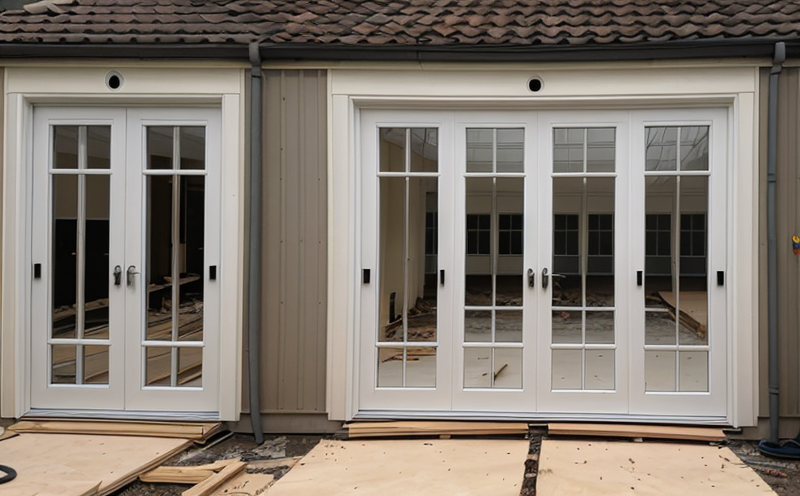Reaction-to-Fire Testing of Partition Materials
The Reaction-to-Fire (RFT) testing of partition materials is a critical aspect of ensuring fire safety in buildings. Partitions, such as walls and partitions within commercial, industrial, and residential structures, are designed to resist the passage of flames or smoke between spaces during a fire event. The quality and composition of these materials directly impact the spread of fire and the overall safety of occupants.
During RFT testing, partition materials undergo rigorous evaluation using standardized test methods like ISO 13501-2:2016. This method assesses how a material behaves when exposed to flames in a controlled environment. The objective is to determine the flame spread index (FSI) and smoke production class (SPC). The FSI measures how quickly the fire spreads along the surface of the partition, while SPC quantifies the amount of smoke produced by the material.
The test setup involves placing a specimen of the partition material in a specially designed furnace. A flame is applied to one side of the specimen for a specified duration and height. The behavior of the specimen during this exposure provides critical data on its fire resistance properties. Afterward, the sample is analyzed for char depth, melt-through, and other indicators that can provide insights into the material's performance.
Quality managers and R&D engineers rely on accurate and reliable test results to ensure compliance with local and international standards such as NFPA 251: Standard Methods of Fire Tests of Building Materials and Elements. This ensures that partitions meet safety requirements set forth by regulatory bodies like Underwriters Laboratories (UL) or the National Fire Protection Association.
For procurement teams, understanding RFT testing is essential for selecting materials that will perform reliably under fire conditions. By investing in high-quality partition materials tested to these standards, organizations can enhance their reputation and trustworthiness among clients who prioritize safety and compliance.
Why Choose This Test
The decision to conduct Reaction-to-Fire testing is crucial for several reasons:
- Regulatory Compliance: Ensuring that partitions meet strict fire safety codes and regulations, such as those found in NFPA 251.
- Safety Assurance: Providing peace of mind to building occupants by verifying that partitions will behave predictably during a fire event.
- Performance Validation: Demonstrating the performance capabilities of partition materials under controlled fire conditions, which is essential for R&D and quality assurance processes.
- Cost Efficiency: Early identification of non-compliant materials saves costs associated with rework or replacement during later stages of construction.
- Innovation Support: Testing new materials helps manufacturers identify improvements needed to enhance fire resistance, reducing the risk of product failures in the market.
By choosing Reaction-to-Fire testing for partition materials, organizations can ensure that their products meet stringent safety standards and contribute to safer environments. This proactive approach not only aligns with regulatory requirements but also enhances brand reputation and customer trust.
Customer Impact and Satisfaction
The results of Reaction-to-Fire testing have a direct impact on the satisfaction levels of customers, particularly those in high-risk areas like hospitals, schools, and data centers. When partitions are proven to be fire-resistant through rigorous testing, it instills confidence among occupants about the safety measures in place.
For quality managers and compliance officers, having reliable test results can significantly reduce the risk of non-compliance with regulations. This not only minimizes potential legal liabilities but also ensures that the organization remains compliant with changing standards over time. The ability to demonstrate adherence to international norms like ISO 13501-2:2016 adds credibility and strengthens relationships with clients who prioritize safety.
R&D engineers benefit from Reaction-to-Fire testing by gaining insights into material performance under fire conditions. This information can guide future product development, enabling the creation of safer and more effective partition materials. For procurement teams, selecting suppliers based on successful RFT results ensures that they are working with reputable manufacturers who prioritize quality and safety.
In summary, Reaction-to-Fire testing plays a pivotal role in enhancing customer satisfaction by providing assurance of fire safety measures and supporting continuous improvement efforts within the organization.
Environmental and Sustainability Contributions
The environmental and sustainability benefits of conducting Reaction-to-Fire testing are multifaceted. By ensuring that partitions meet rigorous fire safety standards, organizations contribute to reducing the risk of fires spreading uncontrollably, which can lead to significant environmental damage.
Fire-resistant materials not only protect lives but also help prevent the destruction of property and natural habitats. This is particularly important in areas prone to wildfires or where buildings are located close to forests or other green spaces. The use of fire-resistant partitions can mitigate the spread of flames, thereby preserving ecosystems and biodiversity.
In addition to protecting the environment, Reaction-to-Fire testing supports sustainability goals by promoting the use of materials that are not only safe but also sustainable. For instance, some fire-resistant materials are made from recycled content or renewable resources, which reduces waste and conserves natural resources. These materials often have lower embodied energy compared to traditional construction materials, contributing to a greener footprint.
Organizations that prioritize Reaction-to-Fire testing demonstrate their commitment to sustainability by integrating safety into the broader environmental strategy. This approach not only enhances public trust but also aligns with global initiatives aimed at reducing carbon footprints and promoting sustainable development.





